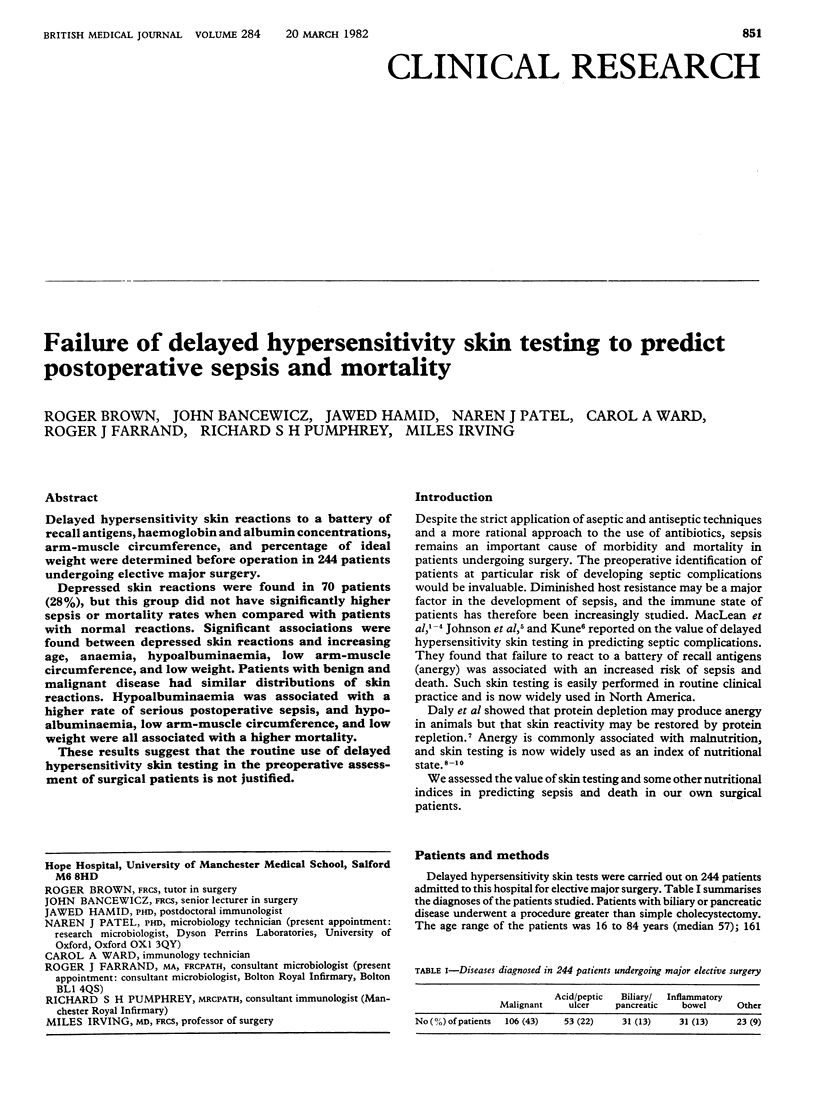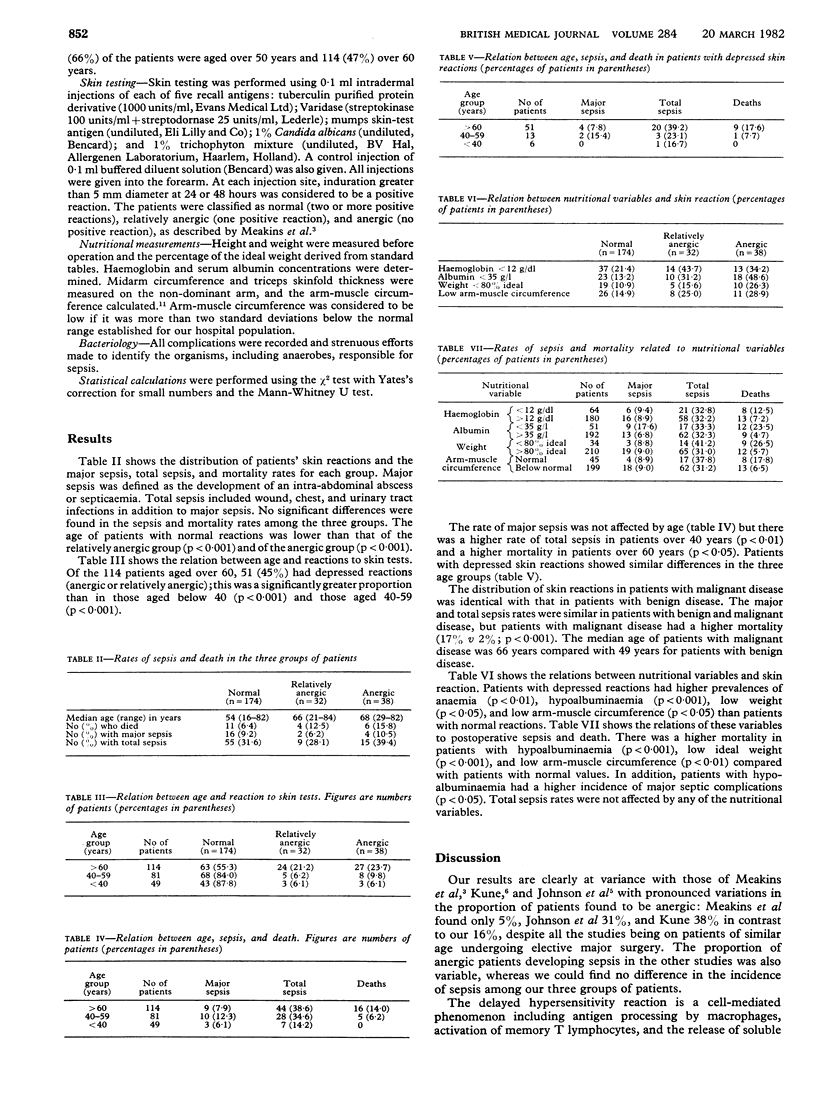Abstract
Delayed hypersensitivity skin reactions to a battery of recall antigens, haemoglobin and albumin concentrations, arm-muscle circumference, and percentage of ideal weight were determined before operation in 244 patients undergoing elective major surgery. Depressed skin reactions were found in 70 patients (28%), but this group did not have significantly higher sepsis or mortality rates when compared with patients with normal reactions. Significant associations were found between depressed skin reactions and increasing age, anaemia, hypoalbuminaemia, low arm-muscle circumference, and low weight. Patients with benign and malignant disease had similar distributions of skin reactions. Hypoalbuminaemia was associated with a higher rate of serious postoperative sepsis, and hypoalbuminaemia, low arm-muscle circumference, and low weight were all associated with a higher mortality. These results suggest that the routine use of delayed hypersensitivity skin testing in the preoperative assessment of surgical patients is not justified.
Full text
PDF


Selected References
These references are in PubMed. This may not be the complete list of references from this article.
- Blackburn G. L., Bistrian B. R., Maini B. S., Schlamm H. T., Smith M. F. Nutritional and metabolic assessment of the hospitalized patient. JPEN J Parenter Enteral Nutr. 1977;1(1):11–22. doi: 10.1177/014860717700100101. [DOI] [PubMed] [Google Scholar]
- Chandra R. K. Immunocompetence in undernutrition. J Pediatr. 1972 Dec;81(6):1194–1200. doi: 10.1016/s0022-3476(72)80262-2. [DOI] [PubMed] [Google Scholar]
- Chandra R. K. Rosette-forming T lymphocytes and cell-mediated immunity in malnutrition. Br Med J. 1974 Sep 7;3(5931):608–609. doi: 10.1136/bmj.3.5931.608. [DOI] [PMC free article] [PubMed] [Google Scholar]
- Christou N. V., Meakins J. L. Delayed hypersensitivity in surgical patients: a mechanism for anergy. Surgery. 1979 Jul;86(1):78–85. [PubMed] [Google Scholar]
- Copeland E. M., Fadyen B. V., Jr, Dudrick S. J. Effect of intravenous hyperalimentation on established delayed hypersensitivity in the cancer patient. Ann Surg. 1976 Jul;184(1):60–64. doi: 10.1097/00000658-197607000-00010. [DOI] [PMC free article] [PubMed] [Google Scholar]
- Daly J. M., Dudrick S. J., Copeland E. M., 3rd Intravenous hyperalimentation. Effect on delayed cutaneous hypersensitivity in cancer patients. Ann Surg. 1980 Nov;192(5):587–592. doi: 10.1097/00000658-198011000-00001. [DOI] [PMC free article] [PubMed] [Google Scholar]
- Daly J. M., Dudrick S. J., Copeland E. M. Effects of protein depletion and repletion on cell-mediated immunity in experimental animals. Ann Surg. 1978 Dec;188(6):791–796. doi: 10.1097/00000658-197812000-00013. [DOI] [PMC free article] [PubMed] [Google Scholar]
- Gurney J. M., Jelliffe D. B. Arm anthropometry in nutritional assessment: nomogram for rapid calculation of muscle circumference and cross-sectional muscle and fat areas. Am J Clin Nutr. 1973 Sep;26(9):912–915. doi: 10.1093/ajcn/26.9.912. [DOI] [PubMed] [Google Scholar]
- Haffejee A. A., Angorn I. B., Brain P. P., Duursma J., Baker L. W. Diminished cellular immunity due to impaired nutrition in oesophageal carcinoma. Br J Surg. 1978 Jul;65(7):480–482. doi: 10.1002/bjs.1800650710. [DOI] [PubMed] [Google Scholar]
- Johnson M. W., Maibach H. I., Salmon S. E. Skin reactivity in patients with cancer. Impaired delayed hypersensitivity or faulty inflammatory response? N Engl J Med. 1971 Jun 3;284(22):1255–1257. doi: 10.1056/NEJM197106032842210. [DOI] [PubMed] [Google Scholar]
- Johnson W. C., Ulrich F., Mequid M. M., Lepak N., Bowe P., Harris P., Alberts L. H., Nabseth D. C. Role of delayed hypersensitivity in predicting postoperative morbidity and mortality. Am J Surg. 1979 Apr;137(4):536–542. doi: 10.1016/0002-9610(79)90127-2. [DOI] [PubMed] [Google Scholar]
- Kune G. A. Life-threatening surgical infection: its development and prediction. Ann R Coll Surg Engl. 1978 Mar;60(2):92–98. [PMC free article] [PubMed] [Google Scholar]
- MacLean L. D., Meakins J. L., Taguchi K., Duignan J. P., Dhillon K. S., Gordon J. Host resistance in sepsis and trauma. Ann Surg. 1975 Sep;182(3):207–217. doi: 10.1097/00000658-197509000-00004. [DOI] [PMC free article] [PubMed] [Google Scholar]
- Meakins J. L., Christou N. V., Shizgal H. M., MacLean L. D. Therapeutic approaches to anergy in surgical patients. Surgery and levamisole. Ann Surg. 1979 Sep;190(3):286–296. doi: 10.1097/00000658-197909000-00003. [DOI] [PMC free article] [PubMed] [Google Scholar]
- Meakins J. L., Pietsch J. B., Bubenick O., Kelly R., Rode H., Gordon J., MacLean L. D. Delayed hypersensitivity: indicator of acquired failure of host defenses in sepsis and trauma. Ann Surg. 1977 Sep;186(3):241–250. doi: 10.1097/00000658-197709000-00002. [DOI] [PMC free article] [PubMed] [Google Scholar]
- Mullen J. L., Buzby G. P., Waldman M. T., Gertner M. H., Hobbs C. L., Rosato E. F. Prediction of operative morbidity and mortality by preoperative nutritional assessment. Surg Forum. 1979;30:80–82. [PubMed] [Google Scholar]
- Pietsch J. B., Meakins J. L., MacLean L. D. The delayed hypersensitivity response: application in clinical surgery. Surgery. 1977 Sep;82(3):349–355. [PubMed] [Google Scholar]


